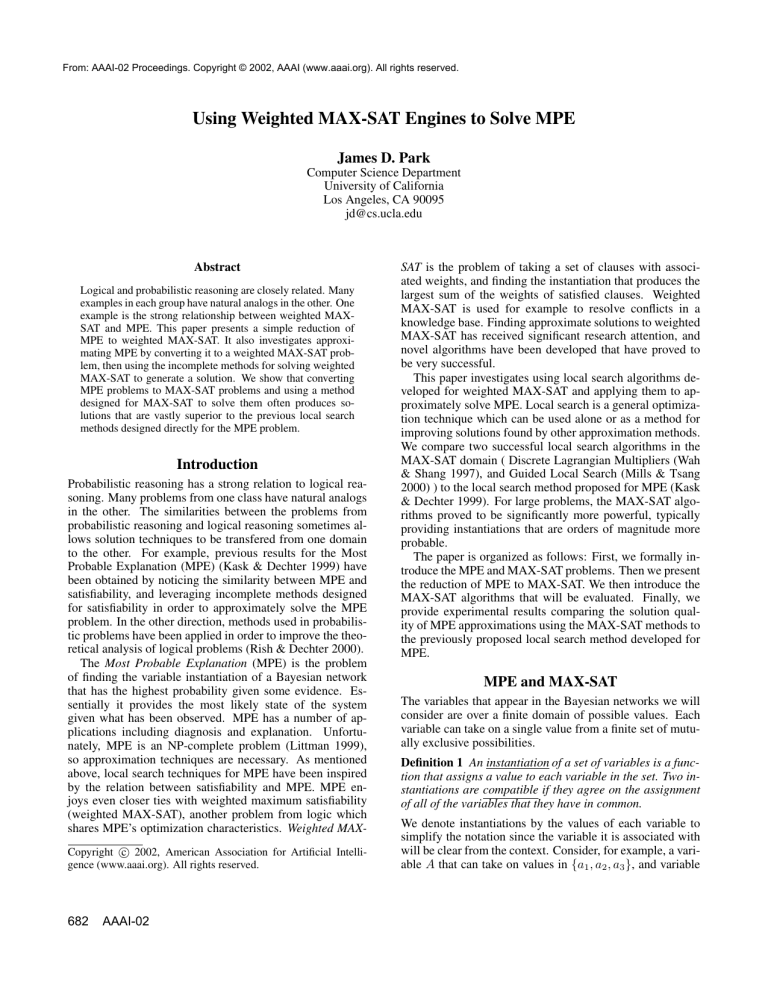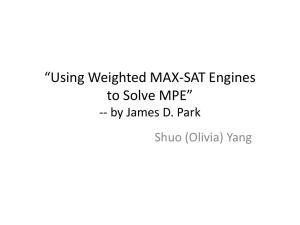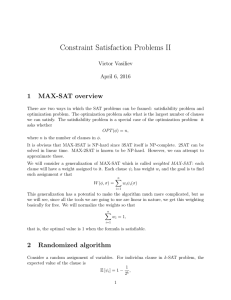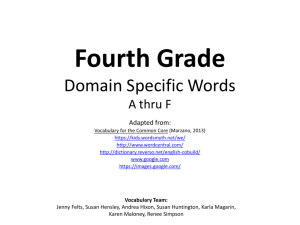
From: AAAI-02 Proceedings. Copyright © 2002, AAAI (www.aaai.org). All rights reserved.
Using Weighted MAX-SAT Engines to Solve MPE
James D. Park
Computer Science Department
University of California
Los Angeles, CA 90095
jd@cs.ucla.edu
Abstract
Logical and probabilistic reasoning are closely related. Many
examples in each group have natural analogs in the other. One
example is the strong relationship between weighted MAXSAT and MPE. This paper presents a simple reduction of
MPE to weighted MAX-SAT. It also investigates approximating MPE by converting it to a weighted MAX-SAT problem, then using the incomplete methods for solving weighted
MAX-SAT to generate a solution. We show that converting
MPE problems to MAX-SAT problems and using a method
designed for MAX-SAT to solve them often produces solutions that are vastly superior to the previous local search
methods designed directly for the MPE problem.
Introduction
Probabilistic reasoning has a strong relation to logical reasoning. Many problems from one class have natural analogs
in the other. The similarities between the problems from
probabilistic reasoning and logical reasoning sometimes allows solution techniques to be transfered from one domain
to the other. For example, previous results for the Most
Probable Explanation (MPE) (Kask & Dechter 1999) have
been obtained by noticing the similarity between MPE and
satisfiability, and leveraging incomplete methods designed
for satisfiability in order to approximately solve the MPE
problem. In the other direction, methods used in probabilistic problems have been applied in order to improve the theoretical analysis of logical problems (Rish & Dechter 2000).
The Most Probable Explanation (MPE) is the problem
of finding the variable instantiation of a Bayesian network
that has the highest probability given some evidence. Essentially it provides the most likely state of the system
given what has been observed. MPE has a number of applications including diagnosis and explanation. Unfortunately, MPE is an NP-complete problem (Littman 1999),
so approximation techniques are necessary. As mentioned
above, local search techniques for MPE have been inspired
by the relation between satisfiability and MPE. MPE enjoys even closer ties with weighted maximum satisfiability
(weighted MAX-SAT), another problem from logic which
shares MPE’s optimization characteristics. Weighted MAXc 2002, American Association for Artificial IntelliCopyright gence (www.aaai.org). All rights reserved.
682
AAAI-02
SAT is the problem of taking a set of clauses with associated weights, and finding the instantiation that produces the
largest sum of the weights of satisfied clauses. Weighted
MAX-SAT is used for example to resolve conflicts in a
knowledge base. Finding approximate solutions to weighted
MAX-SAT has received significant research attention, and
novel algorithms have been developed that have proved to
be very successful.
This paper investigates using local search algorithms developed for weighted MAX-SAT and applying them to approximately solve MPE. Local search is a general optimization technique which can be used alone or as a method for
improving solutions found by other approximation methods.
We compare two successful local search algorithms in the
MAX-SAT domain ( Discrete Lagrangian Multipliers (Wah
& Shang 1997), and Guided Local Search (Mills & Tsang
2000) ) to the local search method proposed for MPE (Kask
& Dechter 1999). For large problems, the MAX-SAT algorithms proved to be significantly more powerful, typically
providing instantiations that are orders of magnitude more
probable.
The paper is organized as follows: First, we formally introduce the MPE and MAX-SAT problems. Then we present
the reduction of MPE to MAX-SAT. We then introduce the
MAX-SAT algorithms that will be evaluated. Finally, we
provide experimental results comparing the solution quality of MPE approximations using the MAX-SAT methods to
the previously proposed local search method developed for
MPE.
MPE and MAX-SAT
The variables that appear in the Bayesian networks we will
consider are over a finite domain of possible values. Each
variable can take on a single value from a finite set of mutually exclusive possibilities.
Definition 1 An instantiation of a set of variables is a function that assigns a value to each variable in the set. Two instantiations are compatible if they agree on the assignment
of all of the variables that they have in common.
We denote instantiations by the values of each variable to
simplify the notation since the variable it is associated with
will be clear from the context. Consider, for example, a variable A that can take on values in {a1 , a2 , a3 }, and variable
A
a1
a2
a3
A
a1
a1
a2
a2
a3
a3
B
b1
b2
b1
b2
b1
b2
P r(A)
.3
.5
.2
P r(B|A)
.2
.8
1
0
.6
.4
Figure 1: CPTs for a Bayesian network A → B.
B that can take on values in {b1 , b2 }. Then instantiation
(a1 ) is compatible with instantiations (a1 , b2 ) and (b3 ), but
not with (a2 , b2 ). For boolean variables, we denote the values by the lowercase variable name or the negated variable
name. For example for boolean variables C and D, the instantiation (c, d) represents the assignment of C to true and
D to false.
Definition 2 A conditional probability table (CPT) T for a
variable V with a set of parent variables P is a function that
maps each instantiation of V ∪P to
a real value in [0, 1] such
that for any instantiation p of P, v T ({v} ∪ p) = 1 where
v ranges over the values of V .
A CPT provides the probability for each possible value of V
given a particular instantiation of the parents. It is called a
table since it is often represented in tabular form, enumerating the conditional probability associated with each instantiation. Figure 1 contains example CPTs corresponding to
P r(A) and P r(B|A)
Bayesian networks represent a probability distribution
over a set of variables, factored into a specific form. It consists of a directed graph which specifies specific independence relationships between the variables, together with a
conditional probability table for each variable. Formally,
Definition 3 A Bayesian network is a pair (G, P) where G
is a directed acyclic graph whose nodes are variables, and
P is a set which consists of the CPT of each variable in G,
where the parents of each CPT correspond to the parents of
the corresponding variable in the graph.
Because of the way Bayesian networks are factored, computing the probability of a complete instantiation of its variables is very simple. The probability of a complete instantiation is the product of the entry of each CPT that is
compatible with the instantiation. For example, in the network in Figure 1 the instantiation (a3 , b1 ) has probability
.2 ∗ .6 = .12
The MPE problem is defined as follows: Given a
Bayesian Network and an instantiation of a subset of the
variables (the evidence), find the (not necessarily unique)
complete instantiation with the highest probability that is
compatible with the evidence.
Now we will consider some related concepts in logical
reasoning. Unlike in probabilistic reasoning, logical reason-
ing deals with propositional variables. We will use the following standard terminology:
Definition 4 A literal is a variable or its negation. A
clause is a disjunction of literals and a weighted clause
is a clause, together with a non-negative weight. A
weighted CNF formula is a set of weighted clauses.
We denote clauses using standard CNF formula conventions. Weights are denoted as superscripts. We denote a
weighted CNF formula by the weighted clauses conjoined
together. For example, the following formula consists of
three weighted clauses : (x ∨ y ∨ z)3 ∧ (x)10.1 ∧ (y).5 . The
weight of a complete instantiation of a weighted CNF formula is the sum of the weight of the satisfied clauses. So, for
the previous example, the instantiation (x, y, z) has weight
3 + .5 = 3.5 since it satisfies the first and third clauses, but
not the second.
The MAX-SAT problem is defined as follows: Given a
weighted CNF formula, find the (not necessarily unique) instantiation which has the highest weight.
Reducing MPE to MAX-SAT
An MPE problem can be converted into a weighted CNF expression whose MAX-SAT solution immediately produces
the solution to the corresponding MPE problem. We begin
by showing how to reduce a Bayesian network with only binary variables and positive CPT entries, and later show how
to extend it to handle zeros, non-binary variables, and evidence.
The basic idea is that each CPT entry induces a weighted
clause in the induced MAX-SAT problem. The only instantiations that do not satisfy the clause l1 ∨ l2 ∨ ... ∨ ln are
the instantiations in which each literal in the clause evaluates to false. We use this fact as the basis of the conversion.
Each row in the CPT generates a weighted clause which contains the negation of each of the variables in the row and is
weighted with the negative log of the conditional probability. For example, the network C → D with CPTs :
C P r(C)
c .3
c .7
C
c
c
c
c
D
d
d
d
d
P r(D|C)
.2
.8
.1
.9
induces the weighted CNF expression
(c)− log .3 ∧ (c)− log .7 ∧ (c ∨ d)− log .2
∧(c ∨ d)− log .8 ∧ (c ∨ d)− log .1 ∧ (c ∨ d)− log .9
.
Consider, for example, the instantiation c, d. It satisfies
all of the clauses except (c)− log .3 and (c ∨ d)− log .8 . So the
sum of weights of the unsatisfied clauses is − log .24 which
is the negative log of the probability of that instantiation.
Notice that for any instantiation of the variables, the sum
of the weights of the unsatisfied clauses equals the negative
AAAI-02
683
log of the probability of the instantiation in the Bayesian
network. This is true in general and forms the basis for the
reduction.
Theorem 1 For any instantiation I of a positive Bayesian
Network which contains only binary variables, the sum of
the weights of the clauses that I leaves unsatisfied in the induced weighted CNF expression equals − log Pr(I).
Proof: The unsatisfied clauses are those in which every
literal evaluates to false. A clause is not satisfied if and only
if the corresponding CPT entry is compatible with the instantiation. Thus the sum of the weights of the unsatisfied
clauses is the sum of the negative logs of the compatible CPT
entries. Since the probability of a complete instantiation I
is the product of the CPT entries compatible with I, the sum
of the weights of the unsatisfied clauses is − log Pr(I).
Maximizing the weight of the satisfied clauses minimizes
the sum of the excluded clauses which is equivalent to maximizing the probability in the original network. Thus solving
the MAX-SAT problem also solves the MPE problem.
Handling Zeros
A CPT entry which has zero probability can not be transformed by the previous transformation because the log of
zero is undefined. This problem can be circumvented by replacing the clause weight − log 0 with a sufficiently large
value w0 . The value must be large enough that it preserves
the ordering of the solution qualities. In other words, if one
instantiation of the Bayesian network has a higher probability than another, the corresponding MAX-SAT instantiations
should be ordered in the same way. Letting w0 be larger than
the sum of all of the weights of the clauses associated with
non-zero CPT entries is sufficient.
Theorem 2 Let w0 be a greater than the sum of the negative logs of the non-zero CPT entries of a Bayesian network
with binary variables. Let the weight of the clauses whose
associated CPT entries are zero have weight w0 , with the
other weights as before. Then, any positive probability instantiation I has a higher score for the weighted CNF expression than any zero probability instantiation. Additionally, the sum of the weights of the unsatisfied clauses for I
remains − log Pr(I).
Proof: Because w0 is larger than the sum of all of the non
w0 weights, any instantiation that satisfies the w 0 clauses (
corresponding to a positive Bayesian network instantiation)
has a higher score than any instantiation that does not satisfy
one of them ( corresponding to a zero probability network
instantiation). For those that satisfy the w0 clauses, the sum
of the unsatisfied clauses remains − log Pr(I), so the solution ordering is preserved.
Replacing − log 0 with a constant has the added benefit
that hill climbing can be performed in the MAX-SAT space,
even when in the MPE space all neighbors of the state have
zero probability.
Beyond Binary Variables
When there are more than 2 possible values for a variable,
we can not interpret it as a single boolean variable. Instead, we introduce a variable (the indicator variable) for
684
AAAI-02
each value the network variable can take on, with additional clauses to enforce the constraint that exactly one of
them must be true. The clauses for the CPT entries are created as before except the indicator variables appear in the
clause instead. An additional weighted clause of the form
(v1 ∨ .... ∨ vn ) with a large weight is introduced to force one
of the values to be true. By choosing a large enough weight,
any locally maximal MAX-SAT instantiation will include at
least one positive assignment of an indicator corresponding
to each network variable. One possible choice for the weight
of a constraint clause for a variable is double the sum of the
weights of the other clauses that contain the corresponding
indicators.
We must also ensure that only one indicator corresponding to a particular network variable is set in the resulting solution. An obvious way to ensure that is to add clauses with
large weight of the form vi ∨ vj for each pair of indicators
associated with a network variable. The problem with this
scheme is that it adds a lot of clauses, which complicates
the problem. There is a simpler alternative. Note that all
of the indicators appear negatively except in the constraint
clause. Thus having multiple indicators instantiated can not
improve the score. In fact, setting more than one indicator for a particular network variable will decrease the score
unless all of the non-constraint clauses that contain the extra variable have weight zero. All we need to ensure is that
each clause contributes some positive weight. This is satisfied automatically for sensible networks since a sufficient
condition is that the network variable does not necessarily
attain a particular value. In other words, for at least one
parent instantiation, it has a probability of less than one of
achieving that value. Still, for completeness such a perverse
network can be handled by adding a small constant to each
of the weights associated with the CPT entry clauses before
computing the weights for the constraint clauses, or by treating that variable as if it were set to the necessary value by
some evidence. Thus we have
Theorem 3 Any locally maximal instantiation of the induced weighted CNF expression satisfies the constraint that
exactly one of the indicator variables is true for each variable. Additionally, the weight of the unsatisfied clauses for
positive probability instantiation I remains − log Pr(I).
To illustrate, we return to our original example. The network from Figure 1 induces the weighted CNF formula
(a1 )− log(.3) ∧ (a2 )− log(.5) ∧ (a3 )− log(.2) ∧
(a1 ∨ a2 ∨ a3 )ωa ∧ (a1 ∨ b1 )− log(.2) ∧ (a1 ∨ b2 )− log(.8) ∧
(a2 ∨ b1 )− log(1) ∧ (a2 ∨ b2 )w0 ∧ (a3 ∨ b1 )− log(.6) ∧
(a3 ∨ b2 )− log(.4) ∧ (b1 ∨ b2 )ωb
where w0 ,ωa , and ωb are chosen as described above.
Entering Evidence
Evidence for a Bayesian network is an instantiation of a subset of its variables. Evidence is entered simply by replacing the propositional variables that correspond to the evidence to their appropriate values then simplifying by dropping any clause that contains true, and removing false from
all clauses. Any clause that would not be satisfied by an instantiation compatible with the evidence would still not be
satisfied for a compatible instantiation over the new problem. Thus the sum of the unsatisfied clauses remains the
same. Continuing with the example, entering evidence (a1 )
replaces a1 with true, and a2 and a3 with false, resulting in
the weighted CNF formula
()− log(.3) ∧ (b1 )− log(.2) ∧ (b2 )− log(.8)
on an extension of constrained optimization using Lagrange
multipliers for continuous variables. In the weighted MAXSAT domain, the clauses are the constraints, and the sum of
the weights of the unsatisfied clauses is the cost function. In
addition to the weight wC , a Lagrangian multiplier λC is associated with each clause C. The cost function function for
DLM is of the form
wC +
λC
C
.
MAX-SAT Algorithms
There are a variety of algorithms in the literature for approximating MAX-SAT. We consider two methods that have
been shown to be particularly effective in solving MAX-SAT
problems. They are the method of Discrete Lagrangian Multipliers (DLM) and Guided Local Search (GLS).
Both of the algorithms that we consider are local search
techniques. Local search is a general optimization technique. The most basic local search method is hill climbing. Hill climbing works by repeatedly improving the
current solution by moving to a better neighboring solution. This continues until no neighbor is a better solution. For our purposes, we define the neighbors of an instantiation to be those instantiations produced by changing which indicator corresponding to a particular network
variable is set. For example, for the MAX-SAT problem induced by the network in Figure 1, the neighbors of
the instantiation (a1 , a2 , a3 , b1 , b2 ) are (a1 , a2 , a3 , b1 , b2 ),
(a1 , a2 , a3 , b1 , b2 ), and (a1 , a2 , a3 , b1 , b2 ).
Both DLM and GLS use hill climbing as a subroutine.
They work by modifying the cost function used to search
each time a local optimum is found. Instead of simply using
the sum of the weights of the unsatisfied clauses as the cost
function, another criteria, which changes throughout execution is chosen. This allows the algorithms to naturally explore the search space even after a local minimum has been
obtained. Empirically this has been shown to be much better
than randomly choosing a new instantiation each time a local minimum is encountered. At a high level they both work
as follows:
do
current=hillClimb(p,current)
augmentCostFunction(p,current)
while(termination condition not met)
Here p is the problem instance. The hillClimb routine iterates through the variables, selecting the best change for each
(as measured by the current cost function) until a local minimum is reached. It also computes the true score (as opposed
to the score for the modified cost function) at each step and
remembers the best state encountered.
The MAX-SAT algorithms we consider differ only in the
way in which they generate the objective function.
Discrete Lagrangian Multipliers
Discrete Lagrangian Multipliers (Wah & Shang 1997) is a
framework for combinatorial optimization subject to constraints. It has a solid theoretical foundation which is based
C
where C ranges over the unsatisfied clauses. Initially, each
λC is zero. Each time a local minimum is encountered, the
λs corresponding to the unsatisfied clauses are increased by
adding a constant.
Guided Local Search
As opposed to the theoretically based DLM, Guided Local
Search (Mills & Tsang 2000) is a heuristically developed
method for solving combinatorial optimization problems. It
has been shown to be extremely successful in solving general weighted MAX-SAT problems. The initial cost function
is the number of unsatisfied clauses. Like DLM, GLS associates an additional weight with each clause. Since the
number of unsatisfied clauses is constant for MPE based
formulas with the neighbor definition
we use, the objective
function essentially becomes C λC where C ranges over
the unsatisfied clauses. When a local minimum is reached,
the weights of some of the unsatisfied clauses are increased.
Specifically, the λs of the unsatisfied clauses with the maximum utility are incremented by 1 where the utility of a
clause C is given by wC /(1 + λC ). Notice that unlike DLM
which increments the λs of all of the unsatisfied clauses,
GLS modifies only a few (often just one) of them.
Additionally, the authors of both algorithms note that it is
advantageous to periodically scale the weights of the the λs
when augmenting the objective function. This prevents the
search space from becoming too rugged. We implemented
the rescaling by multiplying each λ by .8 every 200 times a
local minimum is found.
Experimental Results
We implemented DLM, GLS as well as a previous stochastic local search (SLS) based MPE approximation (Kask &
Dechter 1999) that performed well when compared to other
MPE approximation schemes. SLS is a local search algorithm that at each step performs either a hill climbing
or a stochastic variable change. Periodically the search is
restarted in order to escape local maxima.
For SLS, we used the parameters specified in (Kask &
Dechter 1999). We found no mention of the preferred probability for taking a stochastic flip, so tuned it experimentally.
We used networks drawn from the same distribution as those
in the first data set. The value that worked best was 0.2. For
DLM, the increment used to modify the weights was chosen
in the same manner. The value chosen was 0.02. GLS had
no parameters to tune.
We experimented with three synthetic sets of 100
Bayesian networks consisting of binary variables, and ten
AAAI-02
685
Solution Quality
1
SLS
GLS
DLM
0.9
0.8
Found/Optimal
SLS/GLS
DLM/GLS
0.6
0.5
0.4
0.3
0.2
0.1
0
10
20
30 40 50 60 70
Percent Solved
80
90 100
Figure 2: A plot of the ratios of the approximate solution to
the exact MPE probability. The values are sorted, so that for
a particular point on the X axis it means that X percentage
of the instances had solutions that were at least as far off as
the Y value for that point.
exact
non-zero
SLS
0
0
GLS
100
100
DLM
0
7
Table 1: Only GLS was able to perform well on the deterministic data sets.
real world networks. In the first and second data sets, we
generated networks with 100 variables, and widths1 around
16 in order to be large enough to be difficult for the local
search methods, but small enough to be able to use an exact
algorithm for comparison. We used the method described in
(Darwiche 2001) to generate the network topology. In the
third set each network had 500 variables.We generated the
network topology so that the probability of having an edge
between any two nodes was a constant. This has the effect
of producing very connected networks that are beyond the
reach of structure based methods (they typically have widths
of over 100). The CPTs for the first and third sets were instantiated randomly. In the second, each non-root CPT was
instantiated as a deterministic function of its parents, while
the root CPTs were instantiated randomly. For the first and
second sets, we computed the exact MPE probability in order to be able to compare solutions. We then gave each algorithm 30 seconds per network to generate the best solution
it could. Each algorithm was initialized to start at the same
location.
In all three synthetic experiments, GLS clearly dominated
the other methods. GLS was able to produce the exact an1
The width of a Bayesian network is a property of the network
topology that is related to how connected the network is. The state
of the art algorithms that perform inference on Bayesian networks
typically have complexity that is linear in the number of variables
and exponential in the width.
686
AAAI-02
Median
1x10−10
6x10−7
Best
2x10−7
1x10−3
Table 2: GLS dominated the other methods. We show some
statistics of the ratio of the other methods to GLS. The GLS
solution was several orders of magnitude more probable,
even for the closest solution.
0.7
0
Worst
7x10−14
3x10−11
swer for most of the problems in the first two data sets. In
the third set, we were unable to compute the exact MPE values so we can not tell how close to the exact value each
algorithm achieved, but GLS produced significantly better
solutions than the other methods.
Figure 2 shows the results for the first data set. The ratio
of the probability of the found solution to the probability
of the true solution is plotted for each algorithm. The ratio
values are sorted from worst to best solution quality for each
method. Only GLS was able to compute the exact value of
any problem, and it did so in 65 of the 100 instances. The
lowest score it produced was 0.76 of the optimal value. SLS
and DLM had very similar performance on this data set.
Table 1 shows the result for the second data set. For
the deterministic problems, the vast majority of the instantiations have probability 0. The table shows how many of
the 100 problems that each method was able to solve exactly, as well as how many were able to find a solution with
a non-zero probability. In the deterministic set GLS again
dominated, solving all problems exactly. DLM performed
slightly better than SLS in that it was able to find non zero
solutions for seven of the networks.
In the third set, we again gave each algorithm 30 seconds
per network to produce a solution. These networks were too
connected to produce exact solutions, so we compare only
the relative performance between the algorithms.
GLS significantly outperformed the other methods on the
third data set as well. Table 2 provides some statistics on the
solution quality produced by SLS and DLM relative to GLS.
The worst median, and best columns show the worst median,
and best ratios of the found value to the GLS for the 100
networks. So for example, even at its best, SLS produced a
solution that was only 2x10−7 as large as the GLS solution
for that network.
In each MPE problem in all three synthetic sets, GLS produced a better solution than the other two methods, and in
many cases, produced solutions that were many times better.
We also experimented with 10 real world networks obtained from the Bayesian network repository(Bayesian network repository ). For each network, we ran 20 test cases.
Each test case had 10 randomly selected evidence variables.
Care was taken to ensure that the probability of evidence
was positive. The parameters and time limit were the same
as the ones used for the synthetic network experiments.
The results on the real world networks showed significant
differences in the performance characteristics of the algorithms. Table 3 summarizes the results. For each network
we list the number of variables and the average and maximum number of possible values for its variables. We also
Network
Barley
Diabetes
Link
Mildew
Munin1
Munin2
Munin3
Munin4
Pigs
Water
# vars
48
413
724
35
189
1003
1044
1041
441
32
var insts
avg max
8
67
11
21
2
4
17
100
5
21
5
21
5
21
5
21
3
3
3
4
min
9e-2
1
0
0
0
0
0
0
0
1
SLS/GLS
med max
1e2
9e9
1
1
0
0
1.4
3e1
0
0
0
0
0
0
0
1
0
1
1
1
mid
7e−2
1
0
0
0
0
0
0
1e-19
1
DLM/GLS
med
max
1e2
3e10
1
∞
0
0
1.2
2e1
0
5e3
0
3e76
0 1e101
0 5e111
1e-2
1
1
1
SLS
best > 0
11
20
14
0
0
0
15
19
0
0
0
0
0
0
2
0
1
1
20
20
DLM
best > 0
6
20
20
6
0
0
4
19
1
7
9
9
8
8
8
6
6
20
20
20
GLS
best > 0
3
20
14
0
20
20
7
20
19
20
11
20
12
20
14
18
20
20
20
20
Table 3: Statistics for experiments on 10 real world networks.
provide minimum, median and maximum statistics for the
ratio of SLS and DLM to GLS over the 20 runs. We also
count the number of times the solution was the best of the
three algorithms, as well as the number of positive probability solutions found.
No method dominated the others for all networks. For
networks with a relatively small number of variables with
many values per variable (ex. Barley, Mildew), SLS slightly
outperformed DLM, and significantly outperformed GLS.
For the networks with many variables, GLS and DLM performed significantly better. GLS excelled at finding positive
instantiations, finding a positive instantiation in nearly every
case for every network except Diabetes. It also produced
the best solutions most often for the large networks. DLM
was not able to find as many positive solutions, but for some
of the large networks (ex. Munin2, Munin3, Munin4) generated solutions vastly superior to GLS on those in which it
was able to find a positive solution. We thought that this may
be a result of too little search time for such large problems,
but we found increasing the time limit from 30 seconds to
2 minutes did not qualitatively alter this relationship. It appears from the data we generated, that DLM performance
relative to GLS increases as the number of states per variable increases, although more study would be needed to verify this.
All of the methods have their merits. SLS seems to do
well for networks with few variables and many values per
variable, though it performs poorly on problems in which
the vast majority of instantiations have 0 probability. DLM
performs better than SLS when the number of variables is
increased, and can sometimes outperform GLS. GLS provided the best overall performance, providing the best answer of the three algorithms in the majority of cases. Still,
in a significant minority of the cases for the large networks,
DLM was able to outperform GLS.
MPE.
References
Bayesian
network
repository.
www.cs.huji.ac.il/labs/compbio/Repository.
Darwiche, A. 2001. Recursive conditioning. Artifical Intelligence Journal 125(1-2):5–41.
Kask, K., and Dechter, R. 1999. Stochastic local search for
Bayesian networks. In Workshop on AI and Statistics 99,
113–122.
Littman, M. 1999. Initial experiments in stochastic satisfiability. In Proceedings of the Sixteenth National Conference
on Artificial Intelligence, 667–672.
Mills, P., and Tsang, E. 2000. Guided local search for
solving SAT and weighted MAX-SAT problems. Journal
of Automated Reasoning 24:205–233.
Rish, I., and Dechter, R. 2000. Resolution versus search:
Two strategies for SAT. Journal of Automated Reasoning
24(1/2):225–275.
Wah, B., and Shang, Y. 1997. Discrete Lagrangian-based
search for solving MAX-SAT problems. In Proceedings of
the 15th International Joint Conference on Artificial Intelligence, 378–383.
Conclusion
MPE and MAX-SAT problems are strongly related. The reduction from MPE to MAX-SAT is easy to perform. Using
this conversion, methods for approximating weighted MAXSAT can be leveraged to approximate MPE. Both DLM and
GLS can often provides answers that are far superior to those
produced by the local search method designed directly for
AAAI-02
687







